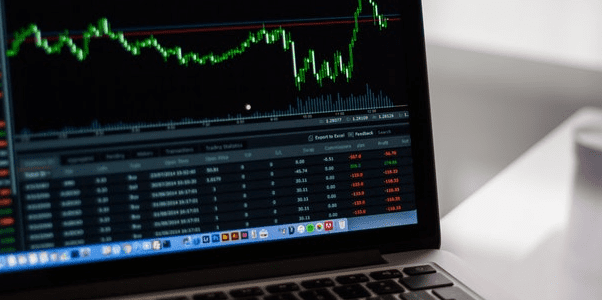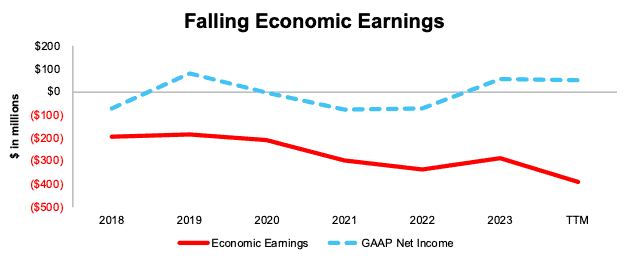With the talking heads spinning narrative’s day in and day out, investing can feel more confused than ever. As the S&P 500 reaches record highs, investors may be wondering how to navigate this market?
There is one straight answer: make sure you’ve done your diligence and understand the true cash flows of the underlying business you’re looking to invest in (or already own).
The sole purpose of our Most Dangerous Stocks Model Portfolio is to find the worst of the worst stocks in any kind of market. The stocks in this Model Portfolio have both terrible fundamentals and expensive valuations. In other words, the risk/reward for these stocks is very dangerous.
To help our readers protect their portfolios, we’re giving you a free stock pick from this Model Portfolio.
This feature provides a concise summary of how we pick stocks for this Model Portfolio. It is not a full Danger Zone report, but it gives you insight into the rigor of our research and approach to picking stocks. Whether you’re a subscriber or not, we think it is important that you’re able to see our research on stocks on a regular basis. We’re proud to share our work. Please feel free to share it with your friends and family.
Keep an eye out for the free pick from our Most Attractive Stocks Model Portfolio, which will be published this week as well! The work that goes into that report is just as valuable
We update this Model Portfolio monthly. The latest Most Attractive and Most Dangerous stocks Model Portfolios were updated and published for clients on February 5, 2024.
Free Most Dangerous Stock Pick: Dayforce Inc. (DAY)
Dayforce Inc. (DAY: $68/share) is the featured stock from February’s Most Dangerous Stocks Model Portfolio.
Dayforce’s net operating profit after tax (NOPAT) margin fell from 9% in 2018 to 5% in the TTM, while the company’s invested capital turns rose from 0.3 to 0.4 over the same time. Falling NOPAT margins offset the improved capital turns and drive Dayforce’s return on invested capital (ROIC) from an already low 2.4% in 2018 to 1.9% in the TTM.
Dayforce’s economic earnings, a key component of the Golden Metric for picking stocks (free training here), fell from -$197 million in 2018 to -$389 million in the TTM. Meanwhile, the company’s GAAP net income rose from -$71 million to $53 million over the same time. Whenever GAAP earnings rise while economic earnings decline, investors should beware.
Figure 1: Dayforce’ Economic vs GAAP Earnings Since 2018
Sources: New Constructs, LLC and company filings
DAY Provides Poor Risk/Reward
Despite its poor and declining fundamentals, Dayforce’s stock is priced for significant profit growth, and we believe the stock is overvalued.
To justify its current price of $68/share, Dayforce must improve its NOPAT margin to 15% (above best-ever NOPAT margin of 10%) and grow revenue by 25% (compared to 15% over the five years) compounded annually over the next eight years. In this scenario, Dayforce grows its NOPAT 35% compounded annually to $2.1 billion in 2033. We think these expectations are overly optimistic, especially considering the company’s NOPAT grew just 4% compounded annually over the last five years.
Even if Dayforce improves its NOPAT margin to 10% (equal to best-ever NOPAT margin) and grows revenue 20% compounded annually through 2033, the stock would be worth no more than $28/share today – a 59% downside to the current stock price.
Each of these scenarios also assumes Dayforce can grow revenue, NOPAT, and FCF without increasing working capital or fixed assets. This assumption is unlikely but allows us to create best case scenarios that demonstrate the high expectations embedded in the current valuation.
Critical Details Found in Financial Filings by Our Robo-Analyst Technology
Below are specifics on the adjustments we made based on Robo-Analyst findings in Dayforce’s 10-Qs and 10-Ks:
Income Statement: we made around $50 million in adjustments, with a net effect of removing just under $50 million in non-operating expenses. Professional members can see all adjustments made to Dayforce’s income statement on the GAAP Reconciliation tab on the Ratings page on our website.
Balance Sheet: we made over $1.1 billion in adjustments to calculate invested capital with a net decrease of just under $200 million. One of the most notable adjustments was for other comprehensive income. Professional members can see all adjustments made to Dayforce’s balance sheet on the GAAP Reconciliation tab on the Ratings page on our website.
Valuation: we made just under $1.8 billion in adjustments to shareholder value with a net decrease of just under $1.0 billion. The most notable adjustment to shareholder value was for total debt. Professional members can see all adjustments to Dayforce’s valuation on the GAAP Reconciliation tab on the Ratings page on our website.
This article was originally published on February 21, 2025.
Disclosure: David Trainer, Kyle Guske II, and Hakan Salt receive no compensation to write about any specific stock, style, or theme.
Questions on this report or others? Join our online community and connect with us directly.

